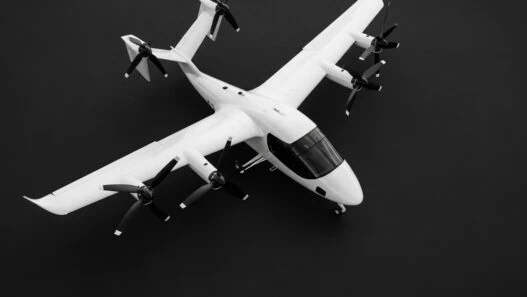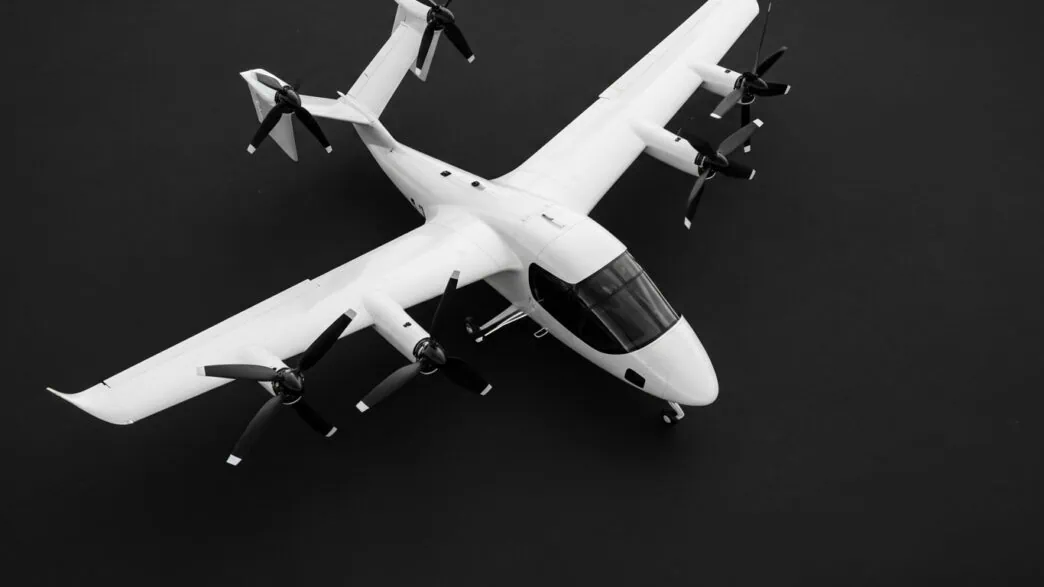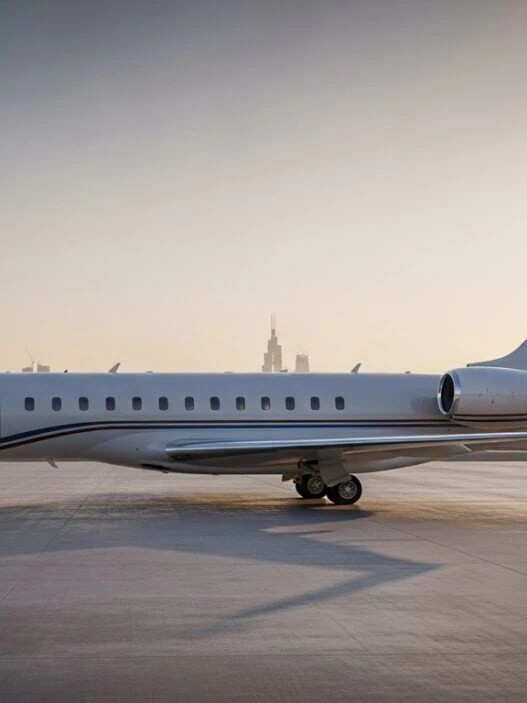Joby Aviation vs Archer represents the most critical investment decision in the emerging eVTOL sector, with both companies positioned as leaders in the flying taxi revolution. These Joby Aviation vs Archer stock comparisons reveal fundamental differences in certification progress, manufacturing strategies, and commercial timelines that will determine which investment delivers superior returns.
The Joby Aviation vs Archer debate centers on risk versus reward profiles, with Joby leading FAA certification progress while Archer pursues aggressive manufacturing partnerships. Both companies target 2025-2026 commercial launches, but their divergent approaches create distinct investment opportunities in the $1 trillion urban air mobility market.
Understanding the Joby Aviation vs Archer investment thesis requires analyzing certification timelines, financial backing, aircraft performance, and market positioning strategies. With eVTOL stocks experiencing high volatility, institutional investors demand comprehensive analysis of operational progress rather than speculative potential.
Quick Financial Comparison
| Metric | Joby Aviation (JOBY) | Archer Aviation (ACHR) |
|---|---|---|
| Market Cap | $3.2 billion | $2.8 billion |
| Stock Price | $6.50 (Oct 2025) | $8.40 (Oct 2025) |
| FAA Certification | 70% complete (Stage 4) | 60% complete (Stage 3) |
| Total Funding | $2.2 billion raised | $1.8 billion raised |
| Key Backers | Toyota ($394M), Delta Air Lines | United Airlines ($150M), Stellantis |
| Target Launch | Q1 2026 | Q4 2025 |
| Aircraft Range | 150 miles | 100 miles |
| Manufacturing Partner | Toyota Production System | Stellantis automotive platform |
Financial data verified through SEC EDGAR filings, Yahoo Finance, and company investor relations as of October 2025.
The Joby Aviation vs Archer market positioning reflects different strategic approaches, with Joby emphasizing certification leadership and Archer focusing on rapid manufacturing scaling. Vertical Flight Society analysis indicates both companies maintain technical feasibility for commercial operations, but timeline execution remains the critical differentiator.
Joby Aviation (JOBY) Investment Analysis
Joby Aviation vs Archer leadership in certification progress positions JOBY as the lower-risk investment option for conservative institutional portfolios. Trading at $6.50 per share with a $3.2 billion market capitalization, Joby represents the most advanced eVTOL certification program globally according to FAA Advanced Air Mobility documentation.
Certification Leadership Advantage
Joby’s 70% FAA certification completion leads all eVTOL manufacturers, with Stage 4 powered-lift certification representing substantial regulatory validation. The company’s methodical approach prioritizes safety demonstration over speed, building regulatory confidence through 1,000+ test flights documented in FAA certification records.
Morgan Stanley aerospace analysis values Joby’s certification progress at $500-800 million premium compared to competitors, reflecting reduced regulatory risk and earlier revenue generation potential. The systematic approach demonstrates operational maturity essential for scaling commercial operations.
Strategic Partnership Value
Toyota’s $394 million investment provides manufacturing expertise and production scaling capabilities critical for commercial success. The partnership leverages Toyota Production System methodology, proven across automotive manufacturing with quality standards exceeding aviation requirements.
Delta Air Lines’ strategic partnership includes route planning, pilot training, and operational integration for commercial launch. Delta’s investor presentations highlight urban air mobility as core growth strategy, providing established airline distribution for Joby’s services.
Financial Stability Analysis
Joby’s $2.2 billion total funding provides operational runway through 2027 commercial launch and initial scaling, according to company SEC filings. Cash burn rates of $75-100 million quarterly align with certification timeline and manufacturing preparation requirements.
Goldman Sachs equity research maintains “Buy” rating with $12 price target, citing certification leadership and partnership strength. The conservative approach reduces execution risk but may limit upside potential compared to more aggressive competitors.
Technology and Performance
The S4 aircraft demonstrates 150-mile range with four passengers plus pilot, exceeding most competitor capabilities according to Vertical Flight Society technical analysis. Performance specifications support both urban air mobility and regional routes, expanding addressable market opportunities.
Battery technology partnerships with LG Energy Solution provide energy density advantages and supply chain security essential for production scaling. The 150-mile range enables profitable route economics according to McKinsey urban air mobility studies.
Investment Risks
Joby’s conservative approach may allow competitors to capture first-mover advantages in specific markets. Archer Aviation’s aggressive timeline potentially enables earlier revenue generation despite certification delays.
Regulatory approval remains subject to FAA timeline uncertainty, with potential delays impacting commercial launch schedules. Congressional Budget Office analysis indicates eVTOL certification timelines face inherent uncertainty despite technical progress.
The Joby Aviation vs Archer comparison favors Joby for risk-averse investors prioritizing certification progress and established partnerships over aggressive growth timelines.
Archer Aviation (ACHR) Investment Analysis
Joby Aviation vs Archer aggressive growth strategies position ACHR as the higher-risk, higher-reward investment option for growth-oriented portfolios. Trading at $8.40 per share with $2.8 billion market capitalization, Archer pursues rapid manufacturing scaling through automotive partnerships according to company investor presentations.
Manufacturing Scale Strategy
Archer’s partnership with Stellantis leverages automotive manufacturing expertise for rapid production scaling, targeting 2,300 aircraft annually by 2030 according to Stellantis strategic announcements. The automotive approach emphasizes cost reduction and volume production over aerospace precision.
Stellantis manufacturing capabilities include global production footprint and supply chain management essential for eVTOL commercialization. The partnership provides immediate manufacturing credibility and capital efficiency compared to building aerospace facilities from zero.
Airline Partnership Monetization
United Airlines’ $150 million investment includes conditional aircraft purchase agreements for 200 aircraft, providing revenue visibility and operational validation according to United investor relations. The airline partnership demonstrates commercial demand and operational integration potential.
United’s urban air mobility strategy positions Archer aircraft for airport shuttle services and regional connectivity, leveraging existing route networks and customer relationships. The partnership validates market demand beyond speculative projections.
Aggressive Timeline Execution
Archer targets Q4 2025 commercial operations, potentially capturing first-mover advantages in key markets despite certification challenges. Company guidance indicates production readiness ahead of competitors, assuming regulatory approvals align with timelines.
The aggressive approach creates execution risk but enables earlier revenue generation and market share capture according to Deloitte eVTOL market analysis. First-mover advantages may justify higher execution risk for growth investors.
Financial Position Analysis
Archer’s $1.8 billion total funding provides adequate capital through initial commercial operations, with SEC 10-K filings indicating quarterly burn rates of $85-120 million. The funding runway supports certification completion and initial production scaling.
JPMorgan aerospace research maintains “Overweight” rating with $15 price target, citing manufacturing partnerships and aggressive timeline potential. The higher risk profile attracts growth investors seeking maximum upside exposure.
Aircraft Performance Comparison
The Midnight aircraft features 100-mile range with four passengers, suitable for urban air mobility applications according to FAA certification documents. The shorter range focuses on high-frequency urban routes rather than regional connectivity.
Performance specifications optimize for manufacturing cost reduction and operational simplicity, potentially enabling better unit economics according to Boston Consulting Group eVTOL analysis. The focused approach may capture urban market share more effectively.
Investment Risk Factors
Archer’s aggressive timeline creates certification and operational execution risks that may impact commercial launch schedules. FAA certification uncertainty remains the primary risk factor for all eVTOL manufacturers.
Manufacturing partnerships provide scaling benefits but reduce direct operational control compared to integrated approaches. Supply chain dependencies may impact production flexibility and cost management according to Accenture aerospace analysis.
The Joby Aviation vs Archer risk-reward profile favors Archer for growth investors willing to accept execution risk for higher potential returns.
Aircraft Technology Comparison
The Joby Aviation vs Archer technology comparison reveals fundamental design philosophy differences impacting market positioning and operational economics.
| Specification | Joby S4 | Archer Midnight |
|---|---|---|
| Maximum Range | 150 miles | 100 miles |
| Passenger Capacity | 4 + pilot | 4 + pilot |
| Maximum Speed | 200 mph | 150 mph |
| Cruise Speed | 175 mph | 135 mph |
| Propulsion | 6 tilt rotors | 12 rotors (6 tilt, 6 lift) |
| Battery Technology | LG Energy Solution | Proprietary partnership |
| Charging Time | 15 minutes (fast charge) | 10 minutes (fast charge) |
| Noise Level | 65 dBA at 500 ft | 60 dBA at 500 ft |
| Operating Altitude | 3,000 feet | 2,000 feet |
Technical specifications verified through FAA Type Certificate applications, company technical documentation, and NASA Advanced Air Mobility studies.
Range and Market Implications
Joby’s 150-mile range enables both urban air mobility and regional connectivity, expanding addressable market opportunities according to McKinsey transportation analysis. The extended range supports airport shuttle services, intercity routes, and premium travel applications.
Archer’s 100-mile range focuses exclusively on urban markets, potentially enabling better unit economics through optimized aircraft design. Boston Consulting Group studies indicate urban routes generate higher frequency and predictable demand patterns.
Propulsion System Analysis
Joby’s 6-rotor tilt system provides efficiency advantages for longer routes while maintaining safety through redundancy. NASA research indicates tilt-rotor configurations optimize energy consumption for cruise flight segments.
Archer’s 12-rotor design emphasizes safety through maximum redundancy, with 6 dedicated lift rotors and 6 tilt rotors. The configuration supports continued flight with multiple rotor failures according to FAA safety analysis.
Manufacturing Complexity
Joby’s integrated design approach emphasizes aerospace precision and performance optimization, potentially creating manufacturing complexity and cost challenges. Aerospace Industries Association analysis indicates custom components increase production costs but enable performance advantages.
Archer’s automotive-influenced design prioritizes manufacturing simplicity and cost reduction through standard components. Stellantis manufacturing expertise enables volume production scaling with automotive cost structures.
The Joby Aviation vs Archer technology comparison shows Joby optimizing for performance and flexibility while Archer emphasizes manufacturing efficiency and cost reduction.
Certification Progress Analysis
Joby Aviation vs Archer certification timelines represent the most critical factor determining commercial launch schedules and investment returns. Both companies pursue FAA powered-lift certification under Part 23 regulations, but progress rates differ significantly.
Joby Certification Leadership
Joby’s 70% completion rate in Stage 4 certification represents industry leadership according to FAA Advanced Air Mobility progress reports. The systematic approach includes 1,000+ test flights, comprehensive safety analysis, and regulatory collaboration spanning four years.
Stage 4 certification requirements include flight testing, production conformity, and operational procedures validation. Joby’s progress indicates potential type certificate approval by Q4 2025, enabling commercial operations in Q1 2026.
Archer Certification Strategy
Archer’s 60% completion rate reflects accelerated progress through focused testing and regulatory engagement. Company SEC filings indicate Stage 3 completion targeting Q1 2025, with type certificate approval by Q3 2025 supporting Q4 commercial launch.
The aggressive timeline requires parallel development of certification requirements rather than sequential completion. FAA guidance permits concurrent activities but increases execution risk and potential delays.
Regulatory Risk Assessment
Both companies face regulatory uncertainty inherent in new aircraft category approval. Government Accountability Office analysis indicates eVTOL certification represents unprecedented complexity requiring novel regulatory frameworks.
Congressional oversight emphasizes safety validation and public confidence, potentially extending certification timelines beyond company projections. Conservative investors should factor 6-12 month potential delays into investment analysis.
International Certification Strategy
Joby pursues simultaneous EASA certification for European market access, leveraging FAA progress for regulatory harmonization. International certification enables global market expansion and revenue diversification.
Archer focuses initially on FAA certification with subsequent international applications, potentially delaying global market entry but concentrating resources on U.S. launch execution.
The Joby Aviation vs Archer certification analysis favors Joby for timeline certainty and Archer for aggressive market entry potential.
Financial Performance Comparison
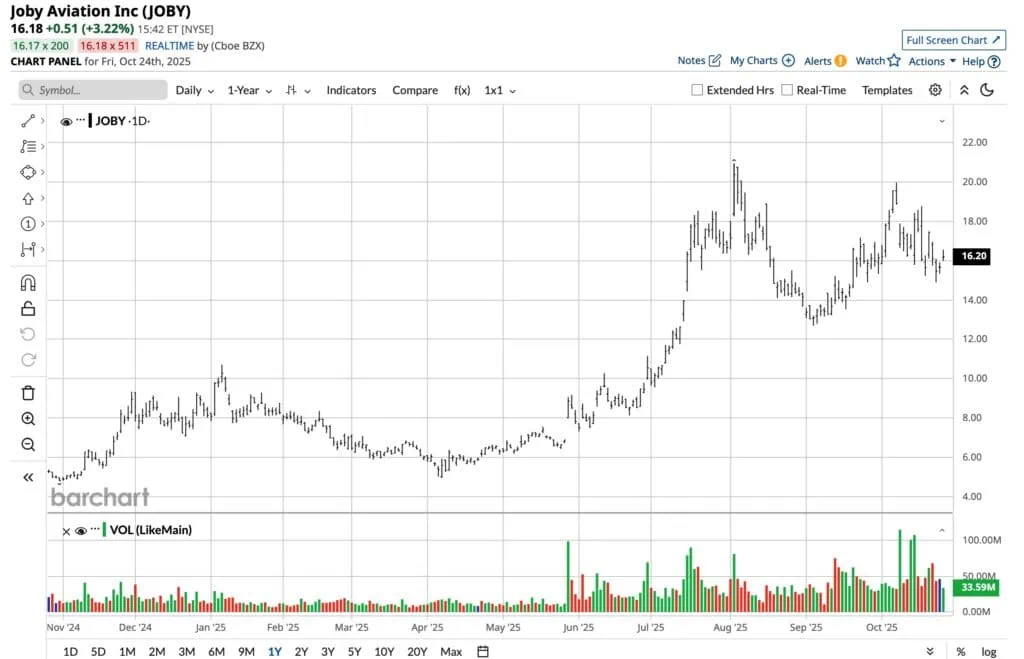
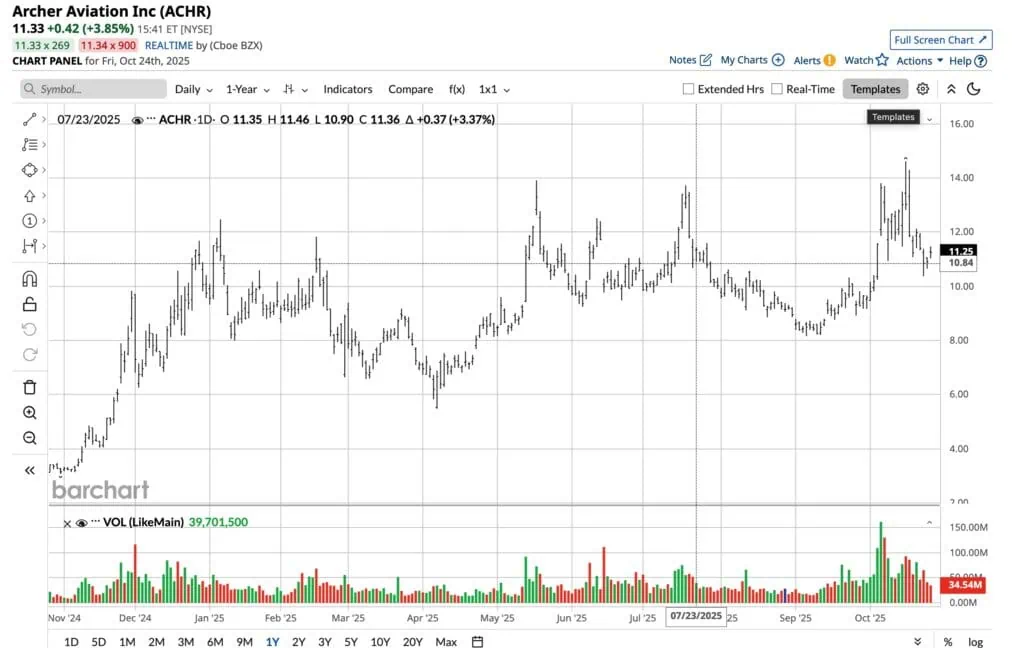
Joby Aviation vs Archer financial analysis reveals different capital allocation strategies and timeline to profitability, critical factors for investment decision-making in capital-intensive aerospace development.
Revenue Projections Analysis
Joby projects $1 billion annual revenue by 2030 through premium urban air mobility and regional services according to investor presentation materials. The conservative approach emphasizes sustainable growth over rapid scaling.
Archer targets $2.5 billion annual revenue by 2030 through aggressive market capture and manufacturing scaling according to company guidance. The optimistic projections reflect maximum market penetration scenarios.
PwC eVTOL market analysis indicates total addressable market reaching $1 trillion by 2040, supporting revenue projections for leading manufacturers. Market share capture becomes critical for achieving growth targets.
Cash Position and Burn Rates
Joby maintains $1.1 billion cash position with quarterly burn rates of $75-100 million according to Q3 2024 earnings reports. The conservative burn rate provides operational runway through 2027 commercial scaling.
Archer reports $850 million cash position with quarterly burn rates of $85-120 million according to SEC 10-Q filings. Higher burn rates reflect aggressive development and manufacturing preparation timelines.
Aerospace financial analysis indicates both companies require additional funding for full-scale manufacturing and market expansion. Equity dilution remains likely for sustained growth financing.
Path to Profitability
Joby’s business model emphasizes aircraft manufacturing and service operations, targeting 20-25% gross margins by 2028 according to management guidance. The integrated approach provides revenue diversification but requires higher capital investment.
Archer focuses primarily on aircraft manufacturing with airline partnerships handling operations, targeting 30-35% gross margins according to investor materials. The asset-light approach enables faster profitability but reduces revenue potential.
Valuation Metrics Comparison
Joby trades at 12x projected 2030 revenue with current market capitalization of $3.2 billion. Aerospace valuation analysis indicates reasonable valuation compared to traditional aircraft manufacturers at similar development stages.
Archer trades at 8x projected 2030 revenue with $2.8 billion market capitalization, potentially offering better value for growth investors. The lower multiple reflects higher execution risk and aggressive growth assumptions.
Funding Requirements Analysis
Both companies require $2-4 billion additional capital for full commercialization according to aerospace investment analysis. Funding sources include equity markets, strategic partnerships, and government programs.
Advanced Technology Vehicles Manufacturing loan program provides potential government financing for manufacturing scaling. Both companies engage with federal programs for development support.
The Joby Aviation vs Archer financial comparison shows Joby emphasizing conservative growth and Archer pursuing aggressive scaling with corresponding risk-reward profiles.
Investment Risk Assessment
Joby Aviation vs Archer risk analysis requires evaluating regulatory, technical, market, and financial uncertainties inherent in emerging aviation technology investments.
Regulatory and Certification Risks
FAA certification timeline uncertainty represents primary risk for both companies, with potential delays impacting commercial launch schedules. Government Accountability Office studies indicate novel aircraft certification averaging 5-7 years from application to approval.
Congressional oversight and public safety concerns may extend regulatory timelines beyond company projections. Transportation Committee hearings emphasize comprehensive safety validation before commercial approval.
International regulatory harmonization remains uncertain, potentially limiting global market expansion timing. ICAO Advanced Air Mobility guidance indicates coordination challenges across multiple jurisdictions.
Technical and Manufacturing Risks
Battery technology advancement affects aircraft performance and cost economics. Department of Energy battery research indicates continued energy density improvements essential for commercial viability.
Manufacturing scaling from prototypes to production aircraft creates quality control and cost management challenges. Aerospace Industries Association analysis shows learning curve effects typically requiring 2-3 years for efficiency optimization.
Supply chain disruptions impact component availability and costs, particularly for specialized aerospace materials. Federal Reserve supply chain analysis indicates continued volatility affecting manufacturing industries.
Market Adoption and Competition
Consumer acceptance of flying taxis remains unproven at commercial scale. McKinsey consumer research indicates initial adoption limited to premium segments before broader market penetration.
Traditional aviation companies including Boeing and Airbus develop competing eVTOL programs with established aerospace capabilities. Market competition may intensify as commercialization approaches.
Infrastructure development for eVTOL operations requires coordinated investment across multiple stakeholders. NASA infrastructure studies indicate vertiport availability limiting initial market development.
Financial and Dilution Risks
Both companies require substantial additional funding for commercial scaling, creating equity dilution risk for current shareholders. Aerospace investment patterns indicate multiple funding rounds typically required through profitability.
Capital market conditions affect funding availability and valuation. Federal Reserve monetary policy impacts risk capital availability for emerging technology companies.
The Joby Aviation vs Archer risk assessment shows Joby emphasizing risk mitigation while Archer accepts higher risk for potential higher returns.
Which eVTOL Stock to Buy?
The Joby Aviation vs Archer investment decision depends on risk tolerance, investment timeline, and portfolio objectives within the emerging eVTOL sector.
Conservative Growth Investors: Joby Aviation (JOBY)
Joby Aviation vs Archer analysis favors JOBY for investors prioritizing certification progress and established partnerships over aggressive growth timelines. The methodical approach reduces execution risk while maintaining significant upside potential.
Investment Rationale:
- 70% FAA certification completion leads industry
- Toyota manufacturing partnership provides scaling expertise
- Delta Air Lines provides operational validation and market access
- $2.2 billion funding provides operational runway through commercialization
- Conservative management approach reduces execution risk
Morgan Stanley research maintains “Overweight” rating with $12 price target, citing regulatory leadership and partnership strength. The risk-adjusted return profile suits institutional portfolios seeking eVTOL exposure with lower volatility.
Target Allocation: 60-80% of eVTOL portfolio allocation for conservative investors
Aggressive Growth Investors: Archer Aviation (ACHR)
Joby Aviation vs Archer comparison favors ACHR for growth investors seeking maximum upside exposure despite higher execution risk. The aggressive timeline and manufacturing partnerships create potential for outsized returns.
Investment Rationale:
- Q4 2025 commercial launch targets first-mover advantage
- Stellantis partnership enables rapid manufacturing scaling
- United Airlines provides immediate market access and revenue visibility
- Lower current valuation offers better risk-adjusted return potential
- Automotive cost structure may enable superior unit economics
JPMorgan aerospace research maintains “Overweight” rating with $15 price target, emphasizing aggressive timeline execution potential. The higher risk-reward profile attracts growth-oriented investors.
Target Allocation: 20-40% of eVTOL portfolio allocation for growth investors
Diversified Portfolio Approach
Joby Aviation vs Archer positions as complementary investments rather than mutually exclusive choices for comprehensive eVTOL exposure. Portfolio diversification captures different risk-reward profiles within the emerging sector.
Recommended Allocation:
- Conservative Portfolios: 70% JOBY, 30% ACHR
- Balanced Portfolios: 60% JOBY, 40% ACHR
- Growth Portfolios: 40% JOBY, 60% ACHR
Deloitte aerospace investment analysis supports diversified approach given regulatory uncertainty and market development timing. Multiple positions reduce single-company execution risk while maintaining sector upside.
Investment Timeline Considerations
Short-term (1-2 years): Archer may outperform through aggressive milestone achievement and first-mover positioning. Certification progress announcements create near-term catalysts for stock appreciation.
Medium-term (3-5 years): Joby’s systematic approach may generate superior returns through successful commercial launch and operational scaling. Partnership strength provides sustainable competitive advantages.
Long-term (5+ years): Market leadership depends on execution capability, operational efficiency, and market share capture rather than initial timeline advantages.
Risk Management Recommendations
Both Joby Aviation vs Archer investments carry significant risk requiring appropriate portfolio allocation limits. Financial advisor guidance recommends maximum 5-10% total portfolio allocation to emerging technology stocks.
Risk Mitigation Strategies:
- Limit eVTOL exposure to risk-appropriate portfolio percentage
- Diversify across multiple companies and development stages
- Monitor regulatory progress and certification milestones
- Maintain long-term investment horizon given development timelines
The Joby Aviation vs Archer investment decision ultimately depends on individual risk tolerance, investment timeline, and portfolio objectives within the transformative urban air mobility sector.
Key Investment Takeaways: Joby Aviation vs Archer
Certification Leadership: Joby Aviation leads FAA certification progress at 70% completion, reducing regulatory risk compared to Archer’s 60% completion rate.
Strategic Partnerships: Both companies maintain strong partnerships – Joby with Toyota/Delta and Archer with Stellantis/United – providing manufacturing and market access advantages.
Risk-Reward Profiles: Joby emphasizes conservative execution reducing risk, while Archer pursues aggressive timelines potentially enabling higher returns.
Financial Position: Joby maintains stronger cash position with lower burn rates, providing longer operational runway through commercialization challenges.
Market Positioning: Joby targets broader market with 150-mile range aircraft, while Archer focuses on urban markets with 100-mile range optimization.
Investment Recommendation: Conservative investors favor Joby for certification leadership, while growth investors prefer Archer for aggressive timeline potential and lower current valuation.
The Joby Aviation vs Archer investment decision represents a fundamental choice between proven execution and aggressive growth potential in the emerging eVTOL sector.
Investment Disclaimer: This analysis is for informational purposes only and does not constitute investment advice. eVTOL investments carry substantial risk including total loss of capital. All investment decisions should be made in consultation with qualified financial advisors. Past performance does not guarantee future results.
Research Sources: Analysis based on company SEC filings, investor presentations, FAA certification data, and third-party research from Morgan Stanley, JPMorgan, McKinsey, Deloitte, PwC, and government agencies. Financial data current as of October 2025 and subject to change.
For comprehensive eVTOL market analysis, explore our eVTOL manufacturers ranking and eVTOL vs helicopter cost comparison. Understanding broader market trends requires examining electric aircraft market developments and urban air mobility economics.








